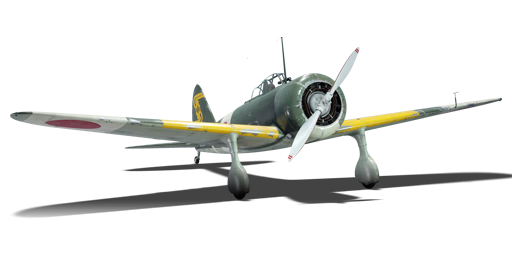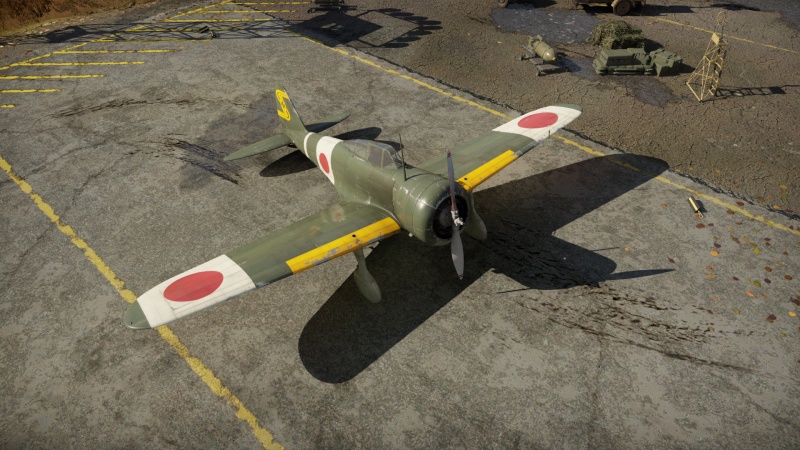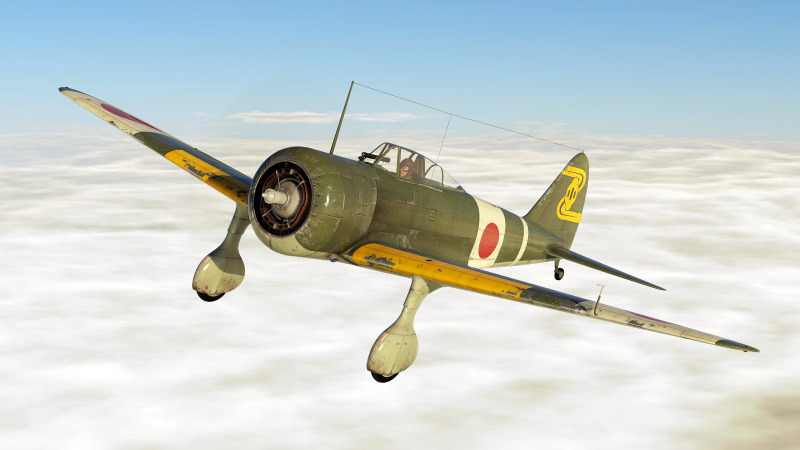Difference between revisions of "Ki-27 otsu Tachiarai"
Colok76286 (talk | contribs) (Edits) |
Colok76286 (talk | contribs) (→Media: Edits) |
||
| Line 177: | Line 177: | ||
;Skins | ;Skins | ||
| − | * | + | * Skins and camouflages for the [[Ki-27 otsu#Media|Ki-27 otsu]] can be used for the {{PAGENAME}}. |
== See also == | == See also == | ||
Revision as of 12:42, 23 August 2021
| This page is about the Japanese fighter Ki-27 otsu Tachiarai. For other variants, see Ki-27 (Family). |
Contents
Description
The Ki-27 otsu Tachiarai is a premium rank I Japanese fighter with a battle rating of 1.3 (AB/SB) and 2.0 (RB). It was introduced in Update "Starfighters".
General info
Flight performance
| Characteristics | Max Speed (km/h at 3,500 m) |
Max altitude (metres) |
Turn time (seconds) |
Rate of climb (metres/second) |
Take-off run (metres) | |||
|---|---|---|---|---|---|---|---|---|
| AB | RB | AB | RB | AB | RB | |||
| Stock | 476 | 465 | 8500 | 10.2 | 10.6 | 8.5 | 8.5 | 180 |
| Upgraded | 517 | 495 | 9.8 | 10.0 | 18.6 | 12.8 | ||
Details
| Features | ||||
|---|---|---|---|---|
| Combat flaps | Take-off flaps | Landing flaps | Air brakes | Arrestor gear |
| X | X | ✓ | X | X |
| Limits | ||||||
|---|---|---|---|---|---|---|
| Wings (km/h) | Gear (km/h) | Flaps (km/h) | Max Static G | |||
| Combat | Take-off | Landing | + | - | ||
| 554 | 550 | N/A | N/A | 220 | ~10 | ~7 |
| Optimal velocities (km/h) | |||
|---|---|---|---|
| Ailerons | Rudder | Elevators | Radiator |
| < 350 | < 350 | < 350 | > 296 |
Survivability and armour
The Ki-27 does not have any armor or self-sealing fuel tanks. There is one fuel tank located above and behind the oil cooling system, and the rest in the wings (2 in each wing).
Modifications and economy
Armaments
Offensive armament
The Ki-27 otsu Tachiarai is armed with:
- 2 x 7.7 mm Type 89 machine guns, -mounted (500 rpg = 1,000 total)
Usage in battles
A superior dogfighter for turn-fighting, the Ki-27 is the first plane to begin showing the features typical of the Japanese "Zero" but with none of the bite. Its speed and manoeuvrability are plagued by engine problems, with no armour and a standard armament.
In battle, no Allied fighter can out-turn you, except for biplanes, but most will outgun you (and even most biplanes match the Ki-27 in armament).
Biplanes (except the I-153 Chaika) make easy prey for the Ki-27, and the Ki-27 can easily outmanoeuvre the P-36 Hawk, the F2A Brewster Buffalo and the I-16 Ishak, but their stronger armaments will knock out a Ki-27 in a single good burst. Simply outrunning any of them is an excellent evasive manoeuvre. Hurricane Mk Is can strictly complete with the Ki-27 Otsu in manoeuvrability, but the Hurricane's heavier armament (four times that of the Ki-27) can also quickly shred a Ki-27. Additionally, outrunning a Hurricane in a Ki-27 is not possible. I-15s, which the Ki-27 historically outperformed, will be the bane of a Ki-27s existence, as their excellent turn ability will force it into energy bleeding manoeuvres or Boom & Zoom style combat. Risky with competition around to abuse either state.
Despite its low battle rating, you can face some challenging foes when flying the Ki-27. Bi-planes will give you a run for your money in terms of manoeuvrability, while some early mono-planes will be faster and more heavily armed than you. Therefore, it is important to judge your foes accordingly.
One of the most challenging opponents is the I-153 Chaika. It is not a mere upgraded I-15bis, but in all performance aspects equal to the Nakajima Ki-27 fighter. Also on the Russian side, the Mig-3 is a significant threat. It is one of the fastest aircraft in its battle rating and has decent armament. In skilled hands, it can be an almost impossible opponent to combat, especially when using Boom & Zoom tactics against you. Your only defence will be to try and outmanoeuvre it or to lure it into a turn fight. The I-16 is also a familiar opponent.
From America, you will face the P-26. They are quite good divers and have a decent roll rate, but will not be able to outmanoeuvre you in a turn fight. The P-36 is more challenging. Faster and well armed, you will have to rely on your turn rate to try and outmanoeuvre them.
Manual Engine Control
| MEC elements | ||||||
|---|---|---|---|---|---|---|
| Mixer | Pitch | Radiator | Supercharger | Turbocharger | ||
| Oil | Water | Type | ||||
| Controllable | Not controllable Not auto controlled |
Controllable Not auto controlled |
Controllable Not auto controlled |
Separate | Not controllable 1 gear |
Not controllable |
Pros and cons
Pros:
- Great manoeuvrability, on par with biplanes
- Good stability in turns
- Good speed, for its tier
- Excellent climb, can reach above 20 m/s
Cons:
- Limited firepower
- Engine overheats rapidly on hot maps
- Engine chokes in negative g dives
- No armour
History
Development
The Nakajima Ki-27 otsu began as the Ki-11, a competitor for the Kawasaki Ki-10 biplane. While faster and more modern than the Ki-10 biplane, the Ki-11 wasn't adopted because the Imperial Japanese Army valued manoeuvrability over speed. Nakajima continued development of the design before finalising the Ki-12, a modern monoplane with a liquid-cooled engine and retractable landing gear, but the Army denied it outright as too maintenance heavy for forward airbases in Manchuria and China. The redesigned plane instead featured a radial air-cooled engine, fixed landing gear and fully enclosed cockpit and received the designation Ki-27.
In 1936, the Ki-27 competed against the Kawasaki Ki-28 (a prototype design fated to never enter production) and the Mitsubishi Ki-33 (a de-navalised A5M). While the Ki-33 outperformed the Ki-27 in most regards, the Imperial Japanese Army was loath to adopt a "navy fighter", and approved the Ki-27 with minor modifications. The Ki-27 entered service as the Army Type 97 Fighter.
Service History
While the Ki-10 would not be finally phased out from front line service until 1942, by 1940, the Ki-27 was the primary army fighter on the front lines. It was unmatched by any plane in the Chinese air force inventory, and outperformed the Soviet I-15 and I-16 fighters in the Battles of Khalkhin Gol, with some pilots scoring 11 kills against Soviet planes in a single day. Against Chinese Curtiss P-36 Hawks, veteran Ki-27 pilots achieved similar, but not as impressive kill rates.
Over China, the Ki-27 was unmatched until the deployment of the P-40 Warhawks with the American Volunteer Group. After America's entry into the war, the Ki-27 also fared poorly against the US Navy's F2A Brewster Buffalo and F4F Wildcat and was removed from most front line service within the first months of the war, replaced by the much-improved Ki-43. However, it remained a front line fighter in Thai service, where the Ki-27 scored recorded kills against P-51s and at least one P-38.
Because of their high production numbers and relatively few losses, Ki-27 would see a renewed role late in the war as Kamikaze planes.
Tachiarai Air Base
In 1919 the Japanese army established the Tachiarai Air Base, located in Fukuoka Prefecture on Japan's southernmost main island of Kyūshū.
The Tachiarai Army Flight School opened in 1940, where during the dire last year of the war many Japanese pilots were crash-coursed on Kamikaze operations. The flight school had a branch school in Chiran, Kagoshima Prefecture, where many Army pilots departed for Kamikaze flights towards the American fleet near Okinawa.
Operations from out Tachiarai ended once American B-29s destroyed the whole base on March 1945.
Tachiarai Peace Museum
In 1987 Tachiarai got reopened as a Peace Museum in a former Tachiarai trainstation, this choice was made to preserve the place where families made their final farewells to their sons departing towards the American fleets. The museum's goal is to preserve peace and maintain tranquility of the souls who departed during the war.
Many items have been gifted, from objects directly from the Air Base and personnel to personal farewell letters. The museum doesn't focus on historical summary of Kamikaze operations, but more aimed at stories of the pilots stationed there.
The Museum has a restored Ki-27 on display, which crashed in 1945 into the bay of Hakata, next to Fukuoka City, in route from Manchuria to Chiran Air Base in order for a Kamikaze depart. The pilot survived the crashlanding, but later made a sortie in another Ki-27. This plane was discovered and pulled out the bay in 1996.
Next to the Ki-27, there's another plane on display outside the Museum, a T-33 training jet derived from the Lockheed F-80
Media
- Skins
- Skins and camouflages for the Ki-27 otsu can be used for the Ki-27 otsu Tachiarai.
See also
Links to the articles on the War Thunder Wiki that you think will be useful for the reader, for example:
- reference to the series of the aircraft;
- links to approximate analogues of other nations and research trees.
External links
| Nakajima Aircraft Company (中島飛行機株式会社 ) | |
|---|---|
| Fighters | Ki-27 otsu · Ki-27 otsu Tachiarai |
| Ki-43-I · Ki-43-II · Ki-43-III otsu | |
| Ki-44-I · Ki-44-I 34 · Ki-44-II otsu · Ki-44-II hei | |
| Ki-84 ko · Ki-84 otsu · Ki-84 hei | |
| Ki-87 | |
| Hydroplanes | A6M2-N* |
| Interceptors | J1N1 · J5N1 |
| Bombers | B5N2 |
| B6N1 Model 11 · B6N2 Model 12 · B6N2a Model 12Ko | |
| G5N1 · G8N1 | |
| Ki-49-I · Ki-49-IIa · Ki-49-IIb · Ki-49-IIb/L | |
| Recon | E8N2 |
| Jet Fighters | Kikka |
| Captured | ␗Ki-27 otsu · ▃Ki-43-II · ␗Ki-43-III ko · ␗Ki-44-II hei · ␗Ki-84 ko |
| *Refit of the Mitsubishi A6M2 mod. 11 | |
| See also | Fuji Heavy Industries (1957-2017) |
| Japan fighters | |
|---|---|
| Navy | |
| Carrier-based fighter | |
| A5M | A5M4 · Hagiri's A5M4 |
| A6M | A6M2 mod. 11 · A6M2 · A6M3 · A6M3 mod. 22 · A6M3 mod. 22Ko · A6M5 · A6M5 Ko · A6M5 otsu · A6M5 Hei · A6M6c |
| A7He | A7He1* |
| A7M | A7M1 (NK9H) · A7M2 |
| Land-based Fighter | |
| J2M | J2M2 · J2M3 · J2M4 Kai · J2M5 · J2M5 (30 mm) |
| J6K | J6K1 |
| J7W | J7W1 |
| N1K-J | N1K1-Ja · N1K2-J · N1K2-Ja |
| Fighter seaplane | |
| N1K | N1K1 |
| A6M-N | A6M2-N |
| Army | |
| Ki-10 | Ki-10-I · Ki-10-I C · Ki-10-II · Ki-10-II C |
| Ki-27 | Ki-27 otsu · Ki-27 otsu Tachiarai |
| Ki-43 | Ki-43-I · Ki-43-II · Ki-43-III otsu |
| Ki-44 | Ki-44-I · Ki-44-I 34 · Ki-44-II otsu · Ki-44-II hei |
| Ki-61 | Ki-61-I ko · Ki-61-I otsu · Ki-61-I hei · Tada's Ki-61-I hei · Ki-61-I tei · Ki-61-II Otsu Kai |
| Ki-84 | Ki-84 ko · Ki-84 otsu · Ki-84 hei |
| Ki-87 | Ki-87 |
| Ki-94 | Ki-94-II |
| Ki-100 | Ki-100 · Ki-100-II |
| Other countries | ▅F4U-1A · ▅P-51C-11-NT · ▅Bf 109 E-7 · ▅Fw 190 A-5 |
| *Imported designation of the He 112 (A6M was in development - A7M would take A7 designation after the cancelation of the A7He) | |
| Japan premium aircraft | |
|---|---|
| Fighters | Hagiri's A5M4 · A7He1 · Ki-27 otsu Tachiarai |
| Ki-44-II otsu · ▅Bf 109 E-7 · ▅F4U-1A · Ki-100-II · Ki-44-I 34 | |
| ▅Fw 190 A-5 · A7M1 (NK9H) · Tada's Ki-61-I hei · ▅P-51C-11-NT | |
| J2M4 Kai · A6M5 Ko · A6M6c · J2M5 · Ki-87 · J6K1 | |
| Twin-engine fighters | Ki-96 |
| Jet fighters | F-86F-40 JASDF▅ · T-2 Early · F-4EJ ADTW |
| Strike aircraft | ▄AV-8S |
| Bombers | Ki-21-I hei · Ki-48-II otsu · H8K3 · B7A2 (Homare 23) · ▅B-17E |






